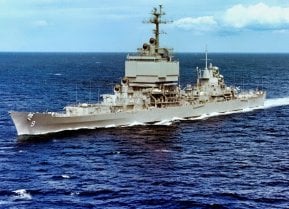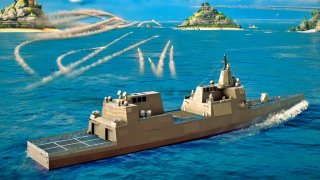Big U.S. Navy Warships: Did Drones and Missiles Just Make Them Obsolete?
Are anti-ship missiles currently sufficient to fully deny a warship access to a region? Perhaps not, given that first the warship must be detected, and then tracked. But the premise is concerning, given the investment of time and money that goes into producing a U.S. Navy warship.
Warfare is always evolving. Tactics and equipment come and go, moving from relevance to obscurity sometimes quickly, sometimes slow.
The bow and arrow, the sword and the shield, were foundational pieces of military equipment for centuries. The horse with a mounted rider also remained fundamental for hundreds of years.
Other times, warfare evolves much too fast for platforms to retain their relevance. The F-117 Nighthawk, one of the world’s first operational stealth aircraft, served for just two decades before it was phased out, its stealth qualities already outdated.
The point here is that times change, and all military equipment eventually goes out of date. Nothing is untouchable – not even the large warships that have formed the bulk of advanced navies for centuries.
With advancements in naval defense systems now proliferating, has the large warship become too vulnerable to survive a modern conflict? Not quite. The warship is not categorically out of date, and the world’s most important militaries are still investing heavily in warships. But current trends suggest the large warship will become increasingly contested, and perhaps less effective as a result.
Rise of the Drones vs. U.S. Navy
Houthi militants have been deploying dozens of small drones in the Red Sea, complicating procedures for U.S. warships in the region. That such an unsophisticated device, deployed from such an unsophisticated adversary, can cause problems for U.S. warships is a concerning development.
“A U.S. destroyer shot down drones and a missile launched by Yemen’s Houthi rebels,” a March 5 Associated Press report read. “The Houthi attack involved bomb-carrying drones.” The U.S. launched a counterattack, which destroyed three bomb-carrying drone boats.
Of course, if the Houthis can disrupt the operations of U.S. warships, then sophisticated nation-states can surely develop drone technology sufficient to disrupt the warship operations of their fellows.
Drones are not the only devices affronting warships.
“Merchant ships and warships in the Red Sea have been under frequent attacks from anti-ship cruise missiles, anti-ship ballistic missiles, explosive surface drones, and aerial drones,” USNI News reported Feb. 19, adding that the Houthis are also using “uncrewed underwater vehicles.”

More Missiles, More Problems
The improvement and proliferation of anti-ship missiles is poised to disrupt warship deployment. China offers an informative example. Beijing has built up an impressive stockpile of intermediate-range and hypersonic missiles, no doubt with the intention of denying adversary warships access to the Indo-Pacific.
Are anti-ship missiles currently sufficient to fully deny a warship access to a region? Perhaps not, given that first the warship must be detected, and then tracked. But the premise is concerning, given the investment of time and money that goes into producing a warship. Deploying an anti-ship missile is a relatively cheap way to counter a warship that can cost billions of dollars and can carry several thousand sailors. Missiles have the potential to create parity between disparately situated nations.
At the moment, nations like the U.S., China, and NATO member-states are still investing in warships, suggesting that the world’s top war planners continue to believe in the viability of the warship. But recent events have raised questions about survivability at sea. And as the history of warfare indicates, no system is untouchable, suggesting that even the mighty warship may one day become fully obsolete.
About the Author: Harrison Kass
Harrison Kass is a defense and national security writer with over 1,000 total pieces on issues involving global affairs. An attorney, pilot, guitarist, and minor pro hockey player, Harrison joined the US Air Force as a Pilot Trainee but was medically discharged. Harrison holds a BA from Lake Forest College, a JD from the University of Oregon, and an MA from New York University. Harrison listens to Dokken.


